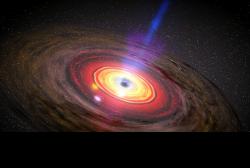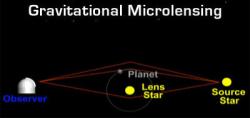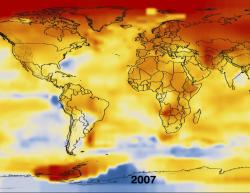Galaxies
![[M galaxy]](http://seds.org/messier/Jco/galaxy.ico.jpg) Click the icon to view galaxies of the Messier catalog
Click the icon to view galaxies of the Messier catalog >>Links; >>References; >>Galaxy Clusters
The icon shows M51, the Whirlpool Galaxy.
Galaxies are large systems of stars and interstellar matter, typically containing several million to some trillion stars, of masses between several million and several trillion times that of our Sun, of an extension of a few thousands to several 100,000s light years, typically separated by millions of light years distance. They come in a variety of flavors: Spiral, lenticular, elliptical and irregular. Besides simple stars, they typically contain various types of star clusters and nebulae.
We live in a giant spiral galaxy, the Milky Way Galaxy, of 100,000 light years diameter and a mass of roughly a trillion solar masses. The nearest dwarf galaxies, satellites of the Milky Way, are only a few 100,000 light years distant, while the nearest giant neighbor, the Andromeda Galaxy, also a spiral, is about 2-3 million light years distant.
![[Spiral]](http://seds.org/messier/Jco/spiral.jpg) Spiral
Spiral
Spiral galaxies usually consist of two major components: A flat, large disk which often contains a lot of interstellar matter (visible sometimes as reddish diffuse emission nebulae, or as dark dust clouds) and young (open) star clusters and associations, which have emerged from them (recognizable from the blueish light of their hottest, short-living, most massive stars), often arranged in conspicuous and striking spiral patterns and/or bar structures, and an ellipsoidally formed bulge component, consisting of an old stellar population without interstellar matter, and often associated with globular clusters. The young stars in the disk are classified as stellar population I, the old bulge stars as population II. The luminosity and mass relation of these components seem to vary in a wide range, giving rise to a classification scheme. The pattern structures in the disk are most probably transient phenomena only, caused by gravitational interaction with neighboring galaxies. Our sun is one of several 100 billion stars in a spiral galaxy, the Milky Way.
![[S0]](http://seds.org/messier/Jco/lenticul.jpg) Lenticular (S0)
Lenticular (S0)
These are, in short, "spiral galaxies without spiral structure", i.e. smooth disk galaxies, where stellar formation has stopped long ago, because the interstellar matter was used up. Therefore, they consist of old population II stars only, or at least chiefly. From their appearance and stellar contents, they can often hardly be distinguished from ellipticals observationally. ![[Elliptical]](http://seds.org/messier/Jco/elliptic.jpg) Elliptical
Elliptical
Elliptical galaxies are actually of ellipsoidal shape, and it is now quite safe from observation that they are usually triaxial (cosmic footballs, as Paul Murdin, David Allen, and David Malin put it). They have little or no global angular momentum, i.e. do not rotate as a whole (of course, the stars still orbit the centers of these galaxies, but the orbits are statistically oriented so that only little net orbital angular momentum sums up). Normally, elliptical galaxies contain very little or no interstellar matter, and consist of old population II stars only: They appear like luminous bulges of spirals, without a disk component. However, for some ellipticals, small disk components have been discovered, so that they may be representatives of one end of a common scheme of galaxy forms which includes the disk galaxies.
![[Irregular]](http://seds.org/messier/Jco/irreg.jpg) Irregular
Irregular
Often due to distortion by the gravitation of their intergalactic neighbors, these galaxies do not fit well into the scheme of disks and ellipsoids, but exhibit peculiar shapes. A subclass of distorted disks is however frequently occuring.
The first known galaxies were longly known before their nature as "island universes" came to light - this fact was finally proven only in 1923 by Edwin Powell Hubble, when he found Cepheid variable stars in the Andromeda Galaxy M31. Ancient observers have known the Milky Way and - on the Southern Hemisphere - the Large and the Small Magellanic Cloud since prehistoric times, and there are speculations that also the Andromeda Galaxy M31 may have been observed and recorded as a nebulous patch by anonymous Babylonian observers around 1,300 B.C.. This object was certainly known to medevial Persian astronomers before 905 A.D., and cataloged and described by Persian astronomer Al Sufi in 964 A.D. All other galaxies have been discovered only after the invention of the telescope: The Triangulum Galaxy M33 was first seen by Italian Priest astronomer G.B. Hodierna before 1654. Next, French astronomer Legentil discovered M32, a companion of the Andromeda Galaxy, in 1749, and his compatriot Abbé Lacaille found M83 in 1752, the first galaxy beyond the Local Group to be discovered. These six were all external galaxies to be known, before Charles Messier started to survey the sky for comets and "nebulae." His first original discovery of a galaxy, M49, a giant elliptical member of the Virgo Cluster, occurred in 1771. The Messier Catalog in his modern form contains 40 galaxies, all but the two Magellanic Clouds that have been found up to 1782. Starting in 1783, William Herschel found and cataloged over 2,500 star clusters and "nebulae" up to 1802, 2,143 of them actually galaxies. J.L.E. Dreyer's NGC catalog contains 6,029 (about 75.9%), and his IC catalog another 3,971 galaxies (about 73.7%).
From their appearance, galaxies are classified in types as given above, as spiral, lenticular, elliptical, and irregular galaxies, where spirals may be further classified for the presence of a bar (S: spirals, SAB: Intermediate, SB: Barred spirals). More precisely, ellipticals are sub-classified for ellipticity from E7 (strongly elongated) to E0 (circular), and spirals for prominence of bulge versus spiral arms from Sa (or SABa, SBa) to Sc or Sd. This so-called Hubble Classification Scheme can well be illustrated by Messier's galaxies:
- Hubble Scheme with Messier galaxies for HTML browser supporting tables (e.g., Netscape, IBM Webexplorer)
- Hubble Scheme for HTML browsers not supporting tables (Lynx, Mosaic)
The most massive galaxies are giants which are a million times more massive than the lightest: Their mass range is from at most some million times that of our Sun in case of the smallest dwarfs, to several trillion solar masses in case of giants like M87 or M77. Accordingly, the number of stars in them varies in the same range.
The linear size of galaxies also scatters, ranging from small dwarfs of few thousands of light years diameter (like M32) to respectable several 100,000 light years. Among the biggest Messier galaxies are the Andromeda galaxy M31 and the bright active Seyfert II galaxy M77.
Our Milky Way Galaxy, a spiral galaxy, is among the massive and big galaxies with at least 250 billion solar masses (there are hints that the total mass may even be as large as 750 billion to 1 trillion times that of the Sun) and a disk diameter of 100,000 light years.
Besides very many individual stars, most galaxies contain the following typical objects:
- Globular star clusters, large but quite compact agglomerations of some 100,000 to several million stars. These large clusters have about the same mass as the smallest galaxies, and are among the oldest objects in galaxies. Often, they form conspicuous systems, and occur at galaxies of every type and size. The globular cluster systems vary in a wide range in richness between the individual galaxies.
- As the stars develop, many of them leave nebulous remnants (planetary nebulae or supernova remnants) which then populate the galaxies.
- While the older stars, including the globular clusters, tend to form an ellipsoidal bulge, the interstellar gas and dust tends to accumulate in clouds near an equatorial disk, which is often conspicuous (i.e., in spiral and lenticular galaxies).
- The interstellar clouds are the places of star formation. More acurately, huge diffuse star-forming nebulae are places where crowded (open) clusters and associations of stars are formed.
- A rather dense galactic nucleus, which is somewhat similar to a "superlarge" globular cluster. In many cases, galactic nuclei contain supermassive dark objects, which are often considered as Black Hole candidates. Some of the more massive and conspicuous globulars are suspected to be the remnants of former nuclei of small galaxies which have been disrupted and cannibalized by larger galaxies.
Some galactic nuclei are remarkably distinguished from the average: These so-called Active Galactic Nuclei (AGNs) are intensive sources of light of all wavelengths from radio to X-rays. The activities seen in the AGNs are caused by gaseous matter falling into, and interacting with, the supermassive central objects mentioned above, according to the current consensus of most researchers. Sometimes, the spectra of these nuclei indicate enormous gaseous masses in rapid motion; galaxies with such a nucleus are called Seyfert galaxies (for their discoverer, Karl Seyfert). M77 is the brightest Seyfert galaxy in the sky. Few galaxies have even more exotic nuclei, which are extremely compact and extremely bright, outshining their whole parent galaxy; these are called quasars (an acronym for QUAsi-StellAR objects). From their properties, quasars resemble extremely active Seyfert galaxy nuclei. However, quasars are so rare and the nearest is so remote that the brightest of them, 3C273, about 2 billion lightyears away in the constellation Virgo, is only of magnitude 13.7, and none of them is in Messier's or even in the NGC or IC catalog.
Occasionally, at irregular intervals given by chance, in any type of galaxies, a supernova occurs: This is a star suddenly brightning to a high luminosity which may well outshine the whole galaxy; the maximal absolute magnitude of a supernova may well reach -19 to -20 magnitudes. This remarkable phenomenon has attracted the attention of many astronomers (equally both professionals and amateurs), who observe galaxies regularly as they "hunt" supernovae. Supernovae have been observed in several Messier catalog galaxies.
According to our current scientific understanding, at least most galaxies (including our Milky Way and those in Messier's catalog) have formed during a comparatively short period, at about the same time, within the first billion years after the universe started to expand, from an initial hot state. Thus they are all almost as old as the universe itself, currently thought to be about 10-15 billion years. It is thought that galaxy formation started when primordial clouds of gaseous matter (hydrogen and helium), the proto-galaxies, were singled out and started to collapse by their own gravity. According to computer simulations, the variety of galaxy forms results from different initial parameters of the proto-galaxies such as the amount of (initial) angular momentum, as well as their later evolution in their environments, such as interaction with other neighboring galaxies.
Messier's galaxies are not deitributed equally across the sky, but can be grouped into a large group of Northern Spring/Southern Fall, and a smaller Northern Fall/Southern Spring group:
- Northern Fall/Southern Spring galaxies (6):
- Northern Spring/Southern Fall galaxies (34):
- Virgo Cluster Galaxies (16): M49, M58, M59, M60, M61, M84, M85, M86, M87, M88, M89, M90, M91, M98, M99, M100.
- Galaxies in Leo (5): M66 group (M65, M66), M96 group (M95, M96, M105).
- Galaxies in and around Ursa Major (11): M81 group (M81, M82), M101, M102, M108, M109, M51 group (M51, M63), M94, M106, M64.
- Southern galaxies (2): M83, M104.

 The Bringer of War
The Bringer of War 











